


Multicast Open Shortest Path First (MOSPF)
MOSPF is an extension to teh OSPF unicast routing protocol and hence requires OSPF as the underlying routing protocol. As such, it uses a new type of OSPF LSA called Group-Membership LSA to advertise teh existence of Group members on networks. These Group Membership LSAs are periodically flooded throughout an area in the same fashion as othe OSPF LSA's. It uses the Dijkstra algoritm to computer the shortest path tree for every source-network group pair. This is shown below,
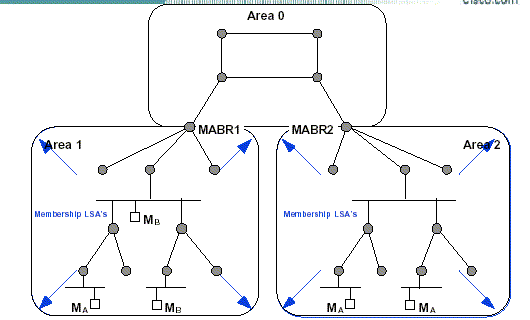
Here, Area 1 has members of both Group A and B while Area 2 only has members of Group A only. Routers with direcly connected members originate Membership LSA's is announcing the existenceof these members on their networks. These LSA's are flooded throughout the area. These Group Membership LSA's do not travel between Area 1 and Area 2.
Once all routers within the area have learned where all the members are in teh network topology, it is possible to construct Source-network trees for the multicast traffic forwarding.
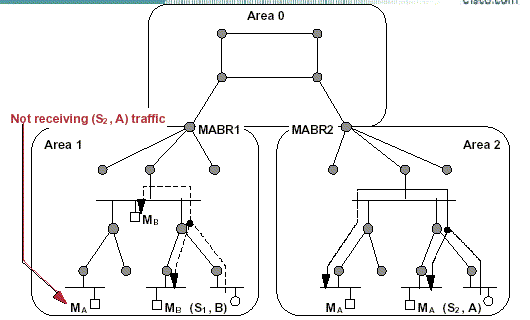
In the above example, Source S1 in Area 1 begins sending multicast traffic to Group B (S1,B). As this data reaches the routers in the area, each runs a Dijkstra calculation and compuets a shortest path tree rooted at the network for S1. This tree spans all members of Group B, and used for forward all multicast traffic for said group.
In area 2, Source 2 S2, begins sending multicast traffic to Group A. Again the routers in the area use the Group Membership information in their MOSPF database to run calculations to find the SPT for the source network where S2 resides. The traffic is then forwarded to (S2,A) as shown.
However, the routers in Area 2 are not aware of the member of Group A in Area 1 as Membership LSA's are not flooded between these two areas. This Inter-Area traffic is handled by another mechanism.
Inter-Area Traffic
In order to transfer multicast traffic between Areas, the concept of 'Wildcard Receivers' is used by MOSPF Area Border Routers (MABR). Wildcard receivers set the 'Wildcard Receiver' Flag in the Router LSA's that they inject into the Area. This flag is equivalent to a whildcard Group Membership LSA that effectively says, I have a direcly connected member for every group'.
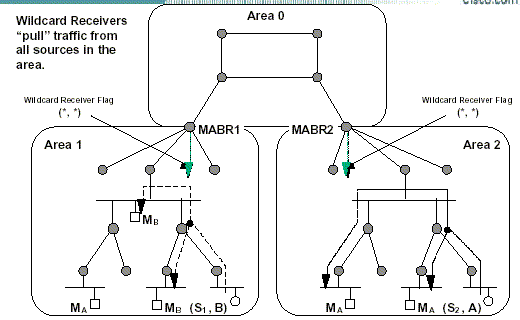
These MABRs connect Areas to the backbone area (Area 0), always set the wildcard receiver flag in their Router LSA's that they are injecting into a non-backbone area. This causes the MABR to be always be added as a branch of hte Shortest Path Tree of any active source in the non-backbone area.
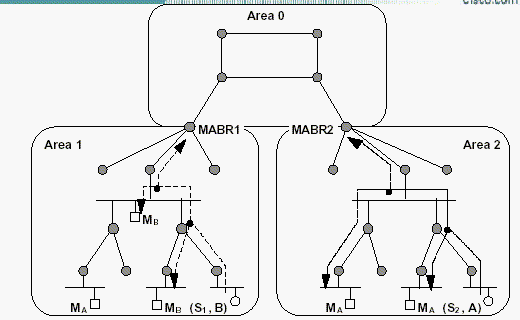
In the example this results in MABR1 being added to the SPT for (S1,B) traffic and MABR2 added to that for (S2,A). This pulls the source traffic in the area to the border router so that it can be sent into the backbone area.
In addition, there is also definition for a new Summary Membership LSA that is used to summarise an area's group membership information. These are inhected into the backbone area, Area 0 so that routers in the backbone area are made aware of the existence of members in other areas.
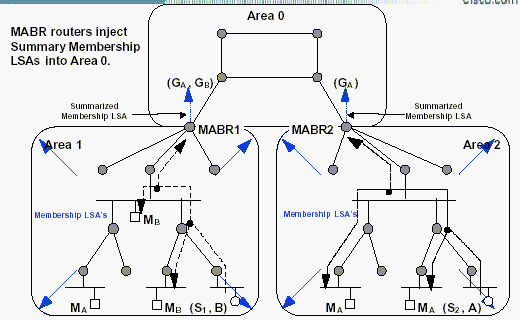
In the above, the existence of members of group A and B in area 1 is being injected into the backbone area by MABR1 via Summary Membership LSA. In addition, MABR2 is injecting a Summary Membership LSA into the backbone area that indicates that Area 2 has members of Group A. Routers int he backbone area now use the information in these Summary Membership LSA's in their Dijkstra calculations to know which MABR's to include in the backbone SPT for which sources.
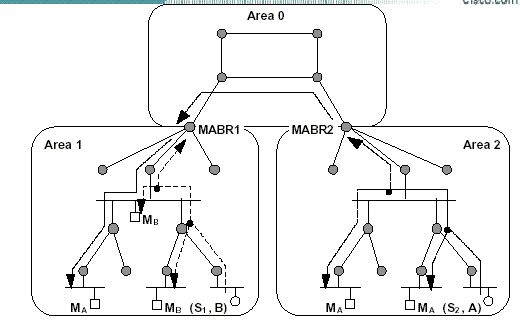
(S2,A) traffic is now flowing from Area 2 into the backbone area (Area 0) via MABR2. The routers in the backbone are fowarding this traffic to MABR1 who is sendin gthe traffic into Area 1. Routers inside of Area 1 run the Dijkstra calculation on (S2,A) traffic to construct a (S2,A) SPT inside of Area 1 to route the traffic to members of Group A as shown.
In the case of when there are no members for a multicast group, traffic is still 'pulled' to the MABR's as a result of the Wildcard Receiver mehcanisms. This can results in bandwidth being consumed inside of the area unncessarily, eg.
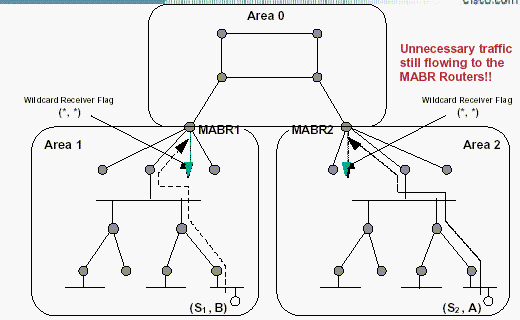
Inter-domain Traffic
Inter-domain traffic flow is basically the same as that for inter-area traffic.
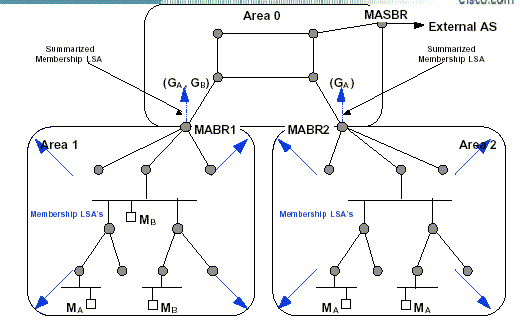
When traffic arrives from outside the domain via the Multicast AS Border Router (MASBR), this traffic is forwarded across the backbone to the MABR's as necessary beased on the Summary Membership LSA's that they have injected into the area.
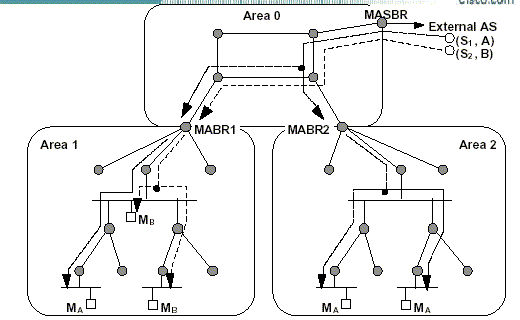
This causes the multicast traffic for Group A and B arriving from outside the AS to be forwarded as shown above. The wildcard receiver mechanism to automatically pull al lsource traffic in the area to them is also present. This allows MASBR;s to forward traffic as needed to the outside world.
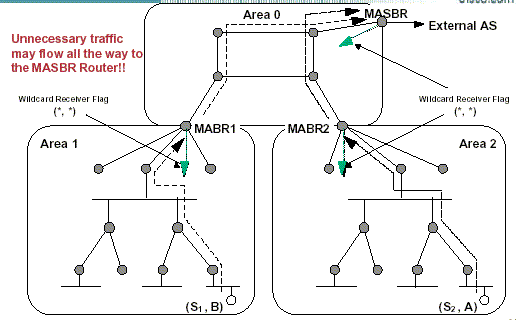
As such, there are significant scaling problems as the flooding of link-state/membership hinders performance and the recalculation of the Dijkstra algorithm is necessary on every single multicast source. Hence, MOSPF is not appropiate for networks with unstable links, too many simultaneous active source-network/group pairs.
| Wed, 23 July, 2003 13:07 |
Room D14, High Energy Particle Physics, Dept. of Physics & Astronomy, UCL, Gower St, London, WC1E 6BT